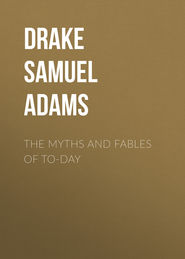По всем вопросам обращайтесь на: info@litportal.ru
(©) 2003-2024.
✖
Nooks and Corners of the New England Coast
Настройки чтения
Размер шрифта
Высота строк
Поля
1692. Governor Fletcher examined three deserters, or renegadoes, as he calls them, from Quebec, who came before him September 23d. They said two men-of-war had arrived at Quebec, and were fitting out for an expedition along the coast, "with a design to fall on Wells, Isle of Shoals, Piscataqua, etc." – "New York Colonial Documents," vol. iii., p. 855.
1724. After the Indians had cut off Captain Winslow and thirteen of his men in the River St. George, encouraged by this success, the enemy made a still greater attempt by water, and seized two shallops at the Isles of Shoals. – Hutchinson's "Massachusetts," vol. ii., p. 307.
107
Mountains seen off the coast: Agamenticus, twelve miles north of the entrance of the Piscataqua; three inferior summits, known as Frost's Hills, at a less distance on the north-west. In New Hampshire the first ridge is twenty or thirty miles from sea, in the towns of Barrington, Nottingham, and Rochester – the summits known as Teneriffe, Saddleback, Tuckaway, etc. Their general name is the Blue Hills. Beyond these are several detached summits – Mount Major, Moose Mountain, etc.; also a third range farther inland, with Chocorua, Ossipee, and Kearsarge. In the lofty ridge, separating the waters of the Merrimac and the Connecticut is Grand Monadnock, twenty-two miles east of the Connecticut River; thirty miles north of this is Sunapee, and forty-eight farther, Moosehillock. The ranges then trend away north-east, and are massed in the White Hills.
108
John Ward Dean, of Boston, the accomplished antiquary, has elicited this and other facts relative to his namesake.
109
On Boone Island it is said there is no soil except what has been carried there.
110
1670. The General Court being informed that there is a ship riding in the road at the Isle of Shoales suspected to be a pirat, and hath pirattically seized the sayd ship and goods from some of the French nation in amity with the English, and doeth not come under comand, this Court doeth declare and order that neither the sayd ship or goods or any of the company shall come into our jurisdiction, or be brought into any of our ports, upon penalty of being seized upon and secured to answer what shall be objected against them. – "Massachusetts Colonial Records," vol. iv., part ii., p. 449.
111
After execution the bodies of the pirates were taken to the little island in Boston harbor known as Nix's Mate, on which there is a monument. Fly was hung in chains, and the other two buried on the beach. The total disappearance of this island before the encroachments of the sea is the foundation of a legend. Bird Island, in the same harbor, on which pirates have been executed, has also disappeared. It formerly contained a considerable area.
112
A somewhat more authentic naval conflict occurred during the war of 1812 with Great Britain, when the American privateer, Governor Plummer, was captured on Jeffrey's Ledge by a British cruiser, the Sir John Sherbroke. The American had previously made many captures. Off Newfoundland she sustained a hard fight with a vessel of twelve guns, sent out to take her. She also beat off six barges sent on the same errand.
113
1686. Ordered that no shipps do unliver any part of their lading at the Isles of Shoals before they have first entered with the Collector of H. M. Customs, and also with the officer receiving his maj
imposts and revenues arising upon wine, sperm, &c., imported either in Boston, Salem, or Piscataqua; and that all shipps and vessells trading to the eastward of Cape Porpus shall enter at some of the aforesaid Ports, or at the town of Falmouth in the Prov. of Maine. – "Massachusetts Council Records," vol. i., p. 43.
114
Boston, 1850: original in possession of Dorchester Antiquarian Society.
115
Mount Wollaston, Quincy, Massachusetts; present residence of John Quincy Adams, Esq.
116
See "Massachusetts Historical Collections," vol. iii., p. 63.
117
British State Papers, Calendars.
118
Spanish ship Sagunto, Carrera, seventy-three days from Cadiz for New York, arrived at Newport on Monday, January 11th, out of provisions and water, and the crew frost-bitten. Cargo, wine, raisins, and salt. Saw no English cruisers, and spoke only one vessel, a Baltimore privateer. —Columbian Centinel, January 16th, 1813.
119
Appledore, a small sea-port of England, County of Devon, parish of Northampton, on the Torridge, at its mouth in Barnstable Bay, two and a quarter miles north of Bideford. It is resorted to in summer as a bathing-place, and has a harbor subordinate to the port of Barnstable. – "Gazetteer."
120
Levett says, "Upon these islands are no salvages at all."
121
Mrs. Celia Laighton Thaxter.
122
The Act of Corporation, though well preserved, appeared little valued; it hung by a corner and in a light that was every day dimming the ink with which it had been engrossed.
123
The reader will do well to consult Belknap's admirable "History of New Hampshire," vol. ii.; Adams's "Annals," or Brewster's "Rambles about Portsmouth." Some sort of defense was begun here very early. In 1665 the commissioners of Charles II. attempted to fortify, but were met by a prohibition from Massachusetts. In 1700 there existed on Great Island a fort mounting thirty guns, pronounced by Earl Bellomont incapable of defending the river. Colonel Romer made the plan of a new work, and recommended a strong tower on the point of Fryer's (Gerrish's) Island, with batteries on Wood and Clark's islands. In December, 1774, John Langdon and John Sullivan committed open rebellion by leading a party to seize the powder here. The fort was then called William and Mary. Old Fort Constitution has the date of 1808 on the key-stone of the arch of the gate-way. Its walls were carried to a certain height with rough stone topped with brick. It was a parallelogram, and mounted barbette guns only. The present work is of granite, inclosing the old walls. The new earth-works on Jaffrey's Point and Gerrish's Island render it of little importance.
124
Governor of New Hampshire from 1682 to 1685. The house is the residence of Mr. Albee.
125
Odiorne's Point is in Rye, New Hampshire. The settlement began under the auspices of a company, in which Gorges and Mason were leading spirits. Their grant covered the territory between the Merrimac and Sagadahoc rivers. Under its authority, David Thompson and others settled at Little Harbor, and built what was subsequently known as Mason's Hall. Disliking his situation, Thompson removed the next spring to the island now bearing his name in Boston Bay. From this nucleus sprung the settlements at Great Island and Portsmouth. The settlement at Hilton's Point was nearly coincident.
126
Peace with the thirteen colonies was proposed under the administration of Rockingham, about the last official act of his life. His name is often met with in Portsmouth.
127
The house stands at the north end of Manning, formerly Wentworth Street, and is thought from its size to have been a public-house. The same house was also occupied by Lieutenant-Governor John, son of Samuel Wentworth. Samuel was the son of William, the first settler of the name. He had been an innkeeper, and had swung his sign of the "Dolphin" on Great Island. Hon. John Wentworth, of Chicago, is the biographer of his family.
128
His second wife was Henrietta du Roy, daughter of Frederick Charles du Roy, generalissimo to the King of Denmark.
129
Bennington, Vermont, is named from Governor Wentworth.
130











